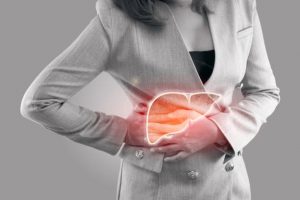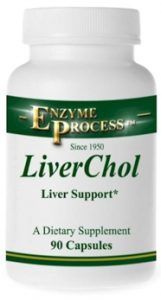Did you know that a teetotaller can also get liver disease? May not sound fair, yet it’s true. You don’t have to be an alcoholic to be diagnosed with fatty liver disease. And, believe it or not, it’s actually quite common these days, affecting 20-40% of the Western world’s population.
What is fatty liver disease?

Although it’s totally normal for the liver to contain a small amount of fat, when fat storage reaches 5 to 15 % of the liver’s total weight, then a person is said to have fatty liver disease.
However there are two main types of this disease: alcoholic fatty liver disease (AFLD), which is directly linked to consuming large quantities of alcohol versus non-alcoholic fatty liver disease (NAFLD), where people have a build up of fat in the liver that is not caused by alcohol use. The main cause, but not the only one, of NAFLD is thought to be a carbohydrate-rich diet where excess glucose is converted to fat cells that are then stored in the liver. In the past 20 years the prevalence of NAFLD has increased progressively, and parallels the rising obesity epidemic worldwide.
So who is at risk?
Suspected risk factors of non-alcoholic fatty liver disease (NAFLD) include: • Being overweight or obese. This is the most prevalent risk factor, particularly if accumulated fat is mostly around the waist.
• Being overweight or obese. This is the most prevalent risk factor, particularly if accumulated fat is mostly around the waist.
• Signs of insulin resistance or metabolic syndrome such as high blood sugar and high levels of fats specifically triglycerides, in the blood, high blood pressure and low HDL cholesterol.
• Some prescription medications may increase the risk of non-alcoholic fatty liver disease.
However NAFLD has been diagnosed in people without any of these risk factors, including young children.
What to look out for
There are not usually any symptoms of NAFLD in the early stages. You probably will not know you have it unless it’s diagnosed during tests carried out for another reason. However in the more advanced stage of NAFLD people may experience:
However in the more advanced stage of NAFLD people may experience:
• a dull or aching pain in upper right abdomen (over the lower right side of the ribs)
• extreme tiredness or weakness
• unexplained weight loss
• nausea
• A build up of fluid and swelling of the legs (edema) and abdomen (ascites)
How is NAFLD diagnosed?
Your health practitioner would probably start with the less expensive and non-invasive screening tools such as a series of blood tests which would include glucose and insulin and of course liver enzyme tests such as ALT and AST. Using the latter and your BMI * a very informative value can be calculated:
HepaticSteatosis Index (HSI) = 8 x (ALT/AST) +BMI (+2 if female, +2 if diabetic).
HSI values below 30 indicate that NAFLD can be ruled out whereas HSI values of 36 and above indicate that a NAFLD positive diagnosis is highly likely.
To confirm the diagnosis a CT scan, MRI, ultrasound or even a liver biopsy may be ordered.
* BMI (body mass index)= weight in kg / (height x height in m) or waist in cm/height in m
Is a fatty liver dangerous?
It can be! If left untreated and it progresses, a fatty liver can be life threatening. The more severe type of NAFLD is NASH, which stands for non-alcoholic steatohepatitis. NASH causes the liver to swell and become damaged and is one of the top causes of cirrhosis in adults.
NAFLD is also linked to an increased risk of liver cancer.
Can it be fixed?
The good news is the liver is highly regenerative (it’s the only organ that is).
If overweight the most highly recommended step to take would be to gradually lose weight (no crash diets). A 2021 meta analysis found every 1kg weight lost was associated with a significant reduction in ALT and AST levels.
Avoid risky substances such as alcohol, cigarettes, processed foods and pharmaceuticals.
And don’t despair as the right diet and supplements can result in a whole new healthy liver.
The best liver-friendly diet
A Mediterranean-ketogenic diet may be the best nutritional intervention for NAFLD. A very low-carbohydrate diet stimulates fatty acid oxidation, causing metabolism to shift from fat storing to fat burning and can lower hepatic fat content within the first few days. This type of diet plan which focuses on whole foods can help people overcome metabolic syndrome, which is closely associated with non-alcoholic fatty liver disease. This nutritional approach can also bring about a shift in the microbiota that favors liver fat metabolism. Microbial dysbiosis has been identified as both an initiator and a significant contributor to both obesity and NAFLD
A very low-carbohydrate diet stimulates fatty acid oxidation, causing metabolism to shift from fat storing to fat burning and can lower hepatic fat content within the first few days. This type of diet plan which focuses on whole foods can help people overcome metabolic syndrome, which is closely associated with non-alcoholic fatty liver disease. This nutritional approach can also bring about a shift in the microbiota that favors liver fat metabolism. Microbial dysbiosis has been identified as both an initiator and a significant contributor to both obesity and NAFLD
The diet emphasizes vegetables, fruits, whole grains, legumes and beneficial fat sources, such as olives, olive oil, avocados and nuts. Include foods rich in omega 3 fatty acids including wild-caught fish like salmon and sardines, chia seeds, flaxseeds and walnuts.
Items rich in vitamin E, such as sunflower seeds and almonds, can help to protect the liver cells from damage and improve the state of a fatty liver.
Bitter foods such as artichokes and bitter, leafy greens like mustard greens and dandelion are great for stimulating bile production.
Supplements are needed here too
Diet alone is not going to fix that liver. Numerous studies have shown what the following can do for a fatty liver and supplements containing at least one or two should be considered:
- Artichoke can reduce blood lipids and ALT and AST levels.
- Berberine improves body weight, lipid profile, hepatic fat content and insulin resistance.
- Chromium picolinate – improves body weight and fat mass, insulin sensitivity and lipid profile.
- CoQ10 can reduced inflammation, liver enzymes and waist circumference.
- Milk thistle can reduce ALT and AST and insulin resistance.
- Tocotrienols in vitamin E can improve the fatty liver index, HSI and insulin resistance index
- Omega-3 improves HDL cholesterol, intra-hepatic liver fat and triglyceride readings.
- Probiotics improve body weight, liver fat, total body fat, liver enzymes and other markers.
As you can see, all is not lost if you are diagnosed with a fatty liver. There is much that can be done to restore your liver back to health.

